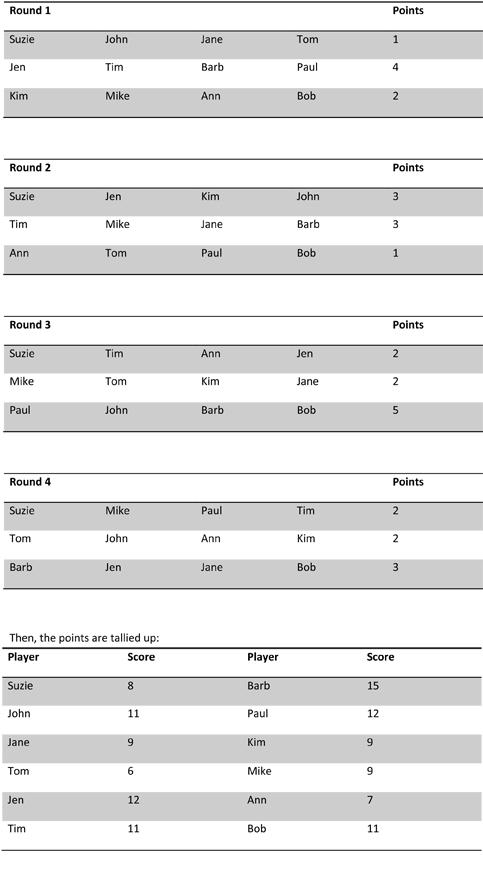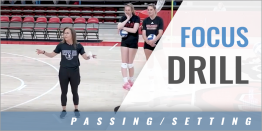|
By: Joe Trinsey - Previously a Coach for Brandywine Volleyball Club Originally published in: Coaching Volleyball Magazine
Legendary North Carolina soccer coach Anson Dorrance popularized the term "competitive cauldron" to describe a system of grading and charting players' practice performance. Many volleyball coaches have adapted his system to their own uses, and today the cauldron is a core component of many USAV and collegiate programs. Many youth coaches are introduced to the concept of the cauldron at the USAV IMPACT course, and the idea of keeping players accountable by constantly grading and scoring practice sessions seems great. However, many of these same coaches are confused about how to actually implement the cauldron. This article will show coaches how and why to do so, even if a coach doesn't have an army of assistants to help. The competitive cauldron helps volleyball players by providing constant competitive motivation - every player wants to compete to be at the top of the list! While the idea of knowing one's performance is being recorded at every practice game can be unnerving at first, this is one of the greatest benefits of the cauldron. After becoming used to being constantly tested at practice, the pressure of a match becomes much easier to handle. Many players find the pressures of a cauldron practice equal to that of a match. Coaches who implement a cauldron find out a great deal of information about their team. They will quickly see which players thrive in a challenging, pressure-filled atmosphere. It also highlights players who do the "little things"; lending quantifiable value to those "intangible" attributes. Indeed, in an interview with the Honolulu Advertiser, former BYU coach Carl McGown recounted how the competitive cauldron showed setter Hector Lebron to be a consistent winner, despite the fact that another setter on the BYU team appeared to be a better, more skilled athlete. Lebron went on to lead BYU to two National Championships. Peter Drucker, the acclaimed business author and consultant, once said, "What gets measured, gets managed." The first consideration for a volleyball coach implementing a cauldron is to decide what will be measured. It is recommended that youth coaches (particularly when coaching athletes under 15) keep track of team points, or mini-game wins and losses, rather than individual stats. USAV CAP Cadre member Stu Sherman notes that this approach teaches the "better the ball" concept; players are motivated to turn a bad pass into a great set, or to figure out how to terminate a poor set. This approach also motivates players to invest in their teammates success, not just their own. Many coaches feel they need several able assistants to keep cauldron stats, but this is not true. By using the "team points" concept, one mark after a point (or mini-game win) scores for all players on the winning team. Even better, a parent volunteer can easily keep these stats as they only need to record when a team wins a point or mini-game. In order for this approach to work successfully, all the groups should be pre-determined and written down on the cauldron sheet ahead of time. If possible, have everybody play with every other player an equal amount. Many coaches have also noted that this increases the pace and organization of practices as there is no time wasted figuring out who the groups will be for the next drill. As a general rule, youth coaches are advised to use competitive 3-contact game variations for cauldron scoring. Make teams of various sizes (2 vs 2, 3 vs 3, 4 vs 6, etc.), and have them play on various court sizes (narrow-court, short-court, full-court, etc.). Single-skill drills do not work well for a team-scoring cauldron. However, this can be seen as a benefit, as coaches will start to emphasize "games" instead of "drills," 3-contact sequences over single-skill repetition, and random training over blocked. As former USA Olympic Coach Marv Dunphy says, "Since we learn best in training situations that are basically game-like, we should incorporate three contact drills as often as possible. I am convinced that the best hitting (setting/passing) drills are pass, set, hit." Using team scoring with the cauldron encourages this mindset. Coaches need not immediately turn their whole practice over to cauldron scoring, and are not recommended to do so. It takes time for the players to adjust, and it also takes most coaches a few practices to get proficient at setting up, running, and scoring cauldron games. A great way to start implementing the cauldron is to run a narrow-court doubles or backrow triples tournament at practice. Have the players play with several different partners, and then post the results at the next practice. Your players will run over to check their score as soon as you post it! A summer camp is also a great time for a coach to practice running cauldron games and displaying the results can foster an intense, competitive atmosphere, especially when players from rival schools are participating. Implementing the cauldron and posting the scores will no doubt raise the competition level of practices, especially in the beginning. However, the most powerful effect comes when cauldron results are tied to playing time. By simply making it a rule that the top 4 scorers over a given period of practices will play all the way around in the game, two things will happen. First, ambiguity and uncertainty over who will play will be eliminated. The players who perform the best in practice will play the most in the matches. Second, the reserve and substitute players have a powerful incentive to work hard and improve, as they are guaranteed a fair shot to beat out the starters. This in turn will motivate the starters to work hard and keep their spots, raising the level of play in practice even higher. One interesting factor is that a team-scoring cauldron system will favor the strongest all-around players, particularly those who can serve and pass, as those skills dominate limited-player mini-games. This is perfect, because serving and passing are the two most important skills, particularly at the youth level. A final decision a coach must make is whether or not to display the results publicly. I personally recommend coaches to do so. Displaying the scores publicly provides accountability for all players and a constant feedback about where they currently stand. Most players run over to the wall as soon as they see the scores are posted. There is some concern that players who continually score at the bottom will have their egos damaged and get discouraged. However, as coaches, it is our job to teach these kids, so that they don't stay at the bottom the whole year! It is also incredibly satisfying when kids who are typically at the bottom (and these kids are aware they are not the stars, with or without the cauldron) get into the top half, even if it is only for a practice or two. It is a great source of pride for these players to outperform one of the team's stars for a particular practice and provides motivation for them to do it again. Many coaches love the cauldron as a concept, think it's a very interesting idea, but ultimately never implement it because they think it is too complicated or they don't have enough staff. Others think it is something that only a national or collegiate team will benefit. I hope I put these myths to bed. If you have a piece of paper and a desire to make every practice session count, then you can start implementing the cauldron today. I promise that you will become as big of a believer as I am! The following tables show how a team scoring cauldron can be implemented. In this case a simple example is shown, using just one game (in this case 4 vs 4) and 12 players on one court. This game could be played using a simple serve + two downball scoring system, with the team who wins two of three scoring the point and staying on in "Monarch of the Court" fashion. 7-minute rounds would mean the game would be completed in a half hour, with enough points scored to show a meaningful difference between certain players.
As you can see, Barb was clearly the highest-scoring player in this game - scoring more than twice as many points as Tom or Ann. In such a small example, it can't be conclusively said whether that was the result of luck or skill, but if this system is used consistently, patterns will start to emerge and the players who have the greatest effect on winning will be at the top. This does tend to heavily favor players who have balanced, all-around skills. However, this is great for youth volleyball coaches who should be striving to teach all of their players multiple skills. More advanced teams can easily track players' scores in the front and back rows and provide separate scores, which can be more informative for specialists such as liberos and middle blockers.
|








